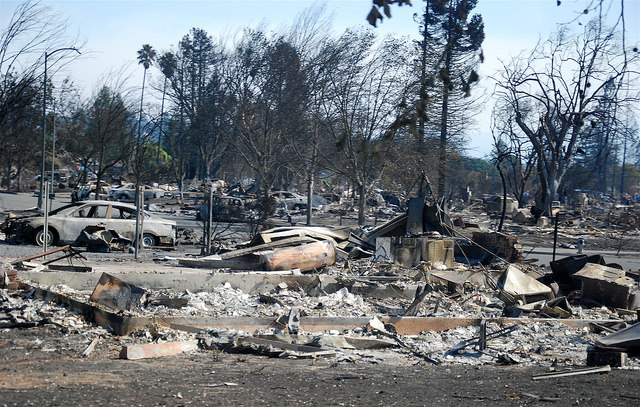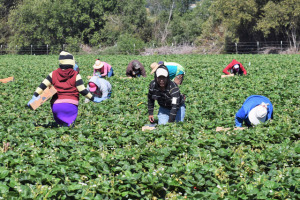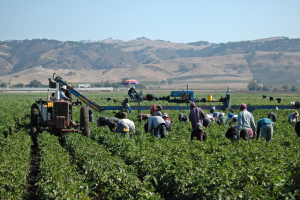
I have lived through my first natural disaster and I know what will make America great again.
November 1, 2017 Michael R. DimockThe fires in Northern California have been horrific, but instructive. They made clear the real enemy of our times. We have entered a dramatic period of climate chaos in which large-scale devastation of communities will be frequent. This is a fact to be embraced. It tells us to employ new approaches to building homes, managing lands and waters. It calls us to cultivate community cohesion and to elect bold and innovative leaders. I believe this because I have lived through my first natural disaster and have seen the power of an awakened community.
The fires were traumatic. It all began for me at 9:30 pm Sunday October 8th when a house two blocks away ignited because of a wind-downed electric wire. But the real drama commenced at 12:12 am on the 9th when my fire alarms went off and the power went out. The drama approached terror at about 1:30 am when exploding propane tanks, cars and homes filled the night, sounding like an artillery barrage. At 3:00 when my sister called from her car saying she and her two kids had evacuated and were coming to my house, I entered a new psychological state. It was living through a disaster. At 6:00, I felt panic. I could not reach my aged parents by phone in the hills above Healdsburg and the news indicated the fires might cut off my ability to reach them. I picked up my brother and we speedily drove north on the back roads to take our parents off the hill. We witnessed a red glow and immense mountain range of dense black smoke that we will never forget. In the end my family was fortunate. No members or homes were harmed. We simply lost sleep, felt fear and breathed toxic air. But it took nearly a month for disturbing dreams of fire and chaos to end.
The devastation is massive. Nearly 200,000 acres burned. Within my circle of friends and acquaintances, close to fifty families lost homes. The fires killed at least 43 individuals; more may succumb to their burns or be found in the ashes. The intensely hot fires destroyed or damaged 8400 structures, including 5% of Santa Rosa’s homes. Governor Brown has called it the greatest natural disaster in California history. I call it California’s latest warning from Mother Nature.
The disaster was equitable. The flames devoured multimillion-dollar estates of the wealthy, middle-income homes of average citizens and the mobile homes of the working or retired poor. Given the wealth and power gap in our community, the recovery may not be as fair, but I will join others to insist it is.
My focus on such disasters began in 2005 when I witnessed the impact of Katrina on New Orleans. I arrived for a meeting of the Slow Food USA board two weeks after the storm waters receded. A small, but shocking sand bar remained in the near-empty lobby of the hotel where we stayed. On my final day, I took a cab with a colleague to have a look at the 9th Ward. As we drove across a large arching bridge we could see the historic community below. Cars, trees and homes were crushed, piled and twisted around each other. It was as if God had used a giant shovel to turn over the community, like a gardener turns their soil to prepare for another season. With time, it became clear that under investment in and mismanagement of the coastline and levees led to immense destruction.
After Katrina, I began to see an intensifying pattern of weather disasters. A quick review of the NOAA database, titled “U.S. Billion-Dollar Weather and Climate Disasters: Table of Events,“ confirms the pattern. The table goes back to 1980 and records the number and amount of US weather-related disasters of $1 billion or more in damages. It includes hurricanes, extreme rains and hail, floods, freezes, heat waves, droughts and wildfires. Notably, the first billion-dollar fire event does not appear until the 1991 Oakland Hills fire. In the decade of the 1980s there were on average 2.7 disasters per year of $1 billion or more in damages. The total cost of damage due to these events was $190.3 billion. By the 2000s there were 4.7 events per year and the total cost was $526.2 billion for the decade. Not counting the recent fires, each of the first seven years of this decade have seen on average 10.8 events. With over two years remaining in this decade, the damages are already estimated to be over $700 billion! Inflation and expanding population do skew the numbers a bit. But clearly, extreme weather events are more destructive and frequent with each passing decade.
UCLA professor, Jared Diamond, has described how societies collapse when humans break the rules of nature, fail to acknowledge realities or cannot coordinate responses to challenges. Some political and economic elites dictating policy today suffer from a dangerous denial and/or hubris leading them to believe that science and technology will save us. The scale of the recent events indicates that Mother Nature is too big and all encompassing for us to overpower. Like an angered mother of a bratty child, she will win any clash of the wills. It is up to us to change our behavior in order to assuage and survive her fury.
Many now acknowledge the reality of our situation. The wealthiest among us are building defendable retreats on remote islands, high mountaintops or in abandoned nuclear missile siloes. Like in the dystopian Blade Runner films, Elon Musk is attempting to find a way off the planet. There are hundreds of places like Sebastopol, California participating in the Transition Town movement. They seek localized and sustainable food, water and energy systems. These are all preparation for what is coming.
After months of watching national leaders impose climate denial on federal agencies, hurricanes destroy cities and islands and massive fires immolate large portions of my own community, I have come to some conclusions.
What is happening is now fully imaginable and cannot be denied. Governor Brown called the wine country devastation “a horror no one could have imagined” when he came and spoke to our community on October 16th. People in wine country, Texas, Florida, Puerto Rico and other Caribbean islands can be heard in news reports saying they experienced something “unprecedented” or “beyond comprehension.” The use of this language reveals a widespread and dangerous subconscious denial that our worst nightmares are occurring. They will continue to occur. If we hope to meet the challenges ahead our denial must die.
Disaster prevention and community protection require robust investment. Much of the destruction caused by the fires could have been prevented or at least lessened with different construction, zoning, and land management practices in place. The fires grew so large and so hot because they had so much fuel. Without fuel, even high winds cannot create a firestorm.
There is evidence that property can be saved even in 70 mile-per hour winds. The Tubbs fire totally consumed my friend’s sister home, but her sixty chickens survived. The birds had thoroughly foraged the fuel around their coop. A nearby nature preserve that had recently done a controlled burn lost no cows because the animals moved into the previously burned area as the flames approached. Structures in Glen Ellen survived even during the high winds because they were built of fire resistant materials and had sufficiently wide and maintained firebreaks around them.
Insurance companies, lenders and government have a role in promoting a new approach to property management. They can provide incentives to use the right building materials, work crews and grazing animals to create and maintain defensible space around structures that are within or abut wild lands. For thousands of years, Native Californians aggressively used fires to tame fuel loads and shape landscapes; we should too.
If as suspected, wind-downed power lines caused the firestorms, let us stop elevating electrical wires. They are too risky in dry grasslands prone to hot winds. It does cost more to bury and safely maintain electrical wires. Yet, in the 53 years since the last firestorm travelled from Calistoga to Santa Rosa it would not have cost $4-6 billion (the estimate for Sonoma County’s fire damage) to bury and maintain the wires that probably sparked the fires. Thinking in longer time frames justifies larger investment to protect communities.
Bold leaders will confront higher authorities and update laws. During the fires Sonoma County’s elected leaders excelled. Assembly members Cecilia Aguiar-Curry and Jim Wood and Senator Mike McGuire hosted remarkable community meetings that built trust. They answered hard questions honestly and demanded information and action from agencies. Sonoma County Supervisors James Gore and Lynda Hopkins consistently included our Spanish-speaking residents in their efforts to coordinate, rally and protect. They were the first to speak of an equitable recovery that will justly serve all community members. Santa Rosa Mayor, Chris Coursey, impressively attended to the psychological and emotional needs of his residents. Rob Giordano, Sonoma County’s Sheriff, lowered fear levels with a calm, but sensitive demeanor, empathetically sharing news about those killed. Then he forcefully opposed Immigration and Customs Enforcement (ICE) when it falsely accused his department of coddling to an undocumented person, whom ICE coldly misrepresented as a potential cause of the firestorm. Our leaders protected and unified with their boldness.
More bold leadership is needed to intelligently amass resources, rebuild neighborhoods and manage lands into the future. Federal officials who deny climate change deserve extreme challenges from local leaders. State and local agencies, particularly planning departments wed to outdated approaches, will need pressure to change. Our elected leaders can apply it. Rewriting federal, state and local laws to fund and guide intelligent development and land management is not easy. Such work calls for the creative, the brave and mighty.
We need one another more than ever. In their 1997 book, The Fourth Turning, Strauss and Howe, predicted that in the early 2000s, the nation would enter a crisis. They wrote that we might pass through that crisis by the mid 2020s. The passage would forge a new unifying national identity. They were optimistic, citing the three previous crises from which the nation emerged stronger: the American Revolution, the Civil War and the combined struggles of the Great Depression and World War II.
I read their book during the dotcom crash in the spring of 2001 and thought, perhaps they were right. When 911 occurred that fall, they seemed even more prescient. Then came Afghanistan, Iraq, Katrina, the Great Recession and now Trump and North Korea; so I know they are right. We are a nation awash in crises.
Climate chaos caused by global warming will make solving these crises harder. Katrina cost $108 billion for a recovery that is still not complete. The latest cost estimate for the 2017 hurricanes is over $200 billion and could reach $300. The wine country fires will add $8 to $10 billion more. As the century progresses, disaster costs will rise; so will the fear. With fear come rage, apathy, addiction, crime and consequently civil unrest. All will further drain public coffers.
Our best antidote to these threats is cohesive community. Looking at the outpouring of love, care and support here in the Bay Area, I am more optimistic about our future. Many people risked their lives to save neighbors, pets, homes, animals and properties. Many others have opened their homes to families who lost theirs. When the disaster agencies could not take all the volunteers that came forward, people spontaneously formed relief projects. They joined with farmers, chefs and grocers to prepare and distribute food to first responders and those without homes. The Teamsters Union brought in and distributed furniture and household items. Many relief funds were formed and nearly $20 million dollars has been raised. In one remarkable example, families and faculty from Sonoma Academy, a preparatory high school in Santa Rosa, provided housing, food, laundry, massage and chiropractic services for a San Francisco Fire Department Strike Team that fought the Nuns fire for eleven days. The crisis brought out the best in people.
I am an optimist despite the devastation I have seen. Yes, the data indicate more pain and suffering lay ahead for our nation. But this will cure our denial. With each disaster communities will learn to better plan and build neighborhoods and manage the land and waters around them. Voters will reward leaders eager to reshape laws and combat old thinking. People will learn that what connects them is greater that what divides them. So Donald Trump and Steve Bannon are correct, we need an enemy to align and energize us, but the enemy is not immigrants, people of color, ISIS or Hillary. Global warming is the enemy that will make America great again.
Photo by Army National Guard photos by Capt. Will Martin/Released
climate change, Fires, Natural disaster, North Bay Fires, Santa Rosa


